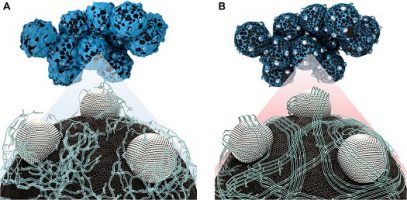PolymPart: Protons (subatomic particles) can be transferred from the anode to the cathode through the ionomer membrane in polymer electrolyte fuel cells (PEFC). Scientists can extend proton pathways by impregnating the ionomer (type of polymer) into the electrodes to achieve improved proton transfer efficiency. Since the impregnated ionomer can mechanically bind catalysts within the electrode, they are known as a binder. In a new report on Science Advances, Chi-Yeong Ahn and a research team introduced a simple approach to use a supercritical fluid and prepare a homogenous nanoscale dispersion of binder material in aqueous alcohol. The preparation showed high dispersion character, crystallinity and proton conductivity for high performance and durable applications in a PEFC cathode electrode.

Polymer electrolyte fuel cells (PEFCs) are electrochemical devices that can efficiently convert chemical energy of the fuel directly into electrical energy. The PEFCs are largely influenced by key components including polymer electrolyte membranes, catalysts and perfluorinated sulfonic acid (PFSA) ionomers. Redox reactions that occur in a PEFC mainly occur at the electrode interface known as the triple phase boundary (TPB) at which the reactant gases (H2 at the anode and O2 at the cathode) can come into contact with platinum (Pt) catalyst particles, on electron-conducting carbon materials (hence the triple phase). In the present study, Ahn et al. described an ionomer dispersion with an average colloidal particle size much smaller than commercially available dispersions by treating a Nafion 117 membrane with aliphatic alcohol under supercritical conditions. The Nafion membrane, a brand name for a perfluorinated sulfonic acid (PFSA) membrane introduced by E. I. du Pont de Nemours and Company in the 1960s, can separate the anode and cathode compartment in proton exchange membrane fuel cells and in water electrolysers.
Surface morphologies and pore distributions of MEAs with conventional D521 ionomer and ND ionomer. SEM results of (A to C and G) MEA with conventional D521 ionomer and (D to F and H) MEA with ND ionomer. (I) MIP results of MEA with conventional D521 ionomer (blue) and ND ionomer (red). The inset is an enlarged graph showing the pore distribution near 0.1 to 10 μm. Credit: Science Advances, doi: 10.1126/sciadv.aaw0870
Supercritical fluids (SCFs) are widely used in industry and research to synthesize special medicine, polymers and nanomaterials, with additional applications to prepare materials for electrochemical studies. However, researchers remain to explore the efficacy of superacidic perfluorinated sulfonic acid (PFSA) ionomers as electrode binders. To accomplish this, Ahn et al. first obtained laboratory-made ionomer dispersion by treating a commercially available Nafion membrane in an aqueous medium of isopropyl alcohol (IPA) in the supercritical fluid state (SCF). Then using dynamic light scattering analysis, the researchers observed ionomer particle distributions with sizes smaller than 100 nm and named the laboratory-made dispersion a ‘nanodispersion’ (ND). The ND underwent a phase transition from an aqueous dispersion to a solid, for its use as a cathode binder. Using X-ray diffraction (XRD) analysis they obtained the crystallinities of ND and showed them as semi-crystalline chains packed uniformly with improved regularity, compared to Nafion D521 used in other PEFC systems. The improved proton conductivity of the ND implied lower resistance; predicting a high-level of performance of the membrane-electrode assembly (MEA) for single-cell operation.
Ahn et al. characterized (tested) the ionomer dispersion made with SCF, using scanning electron microscopy to observe the topography and mercury intrusion porosimetry (MIP) to measure porosities. They observed a relatively uniform surface of the ND on the MEA (membrane-electrode assembly) surface; the ND ionomer was well dispersed on the Pt/C catalyst in the ink slurry to prepare the MEA to begin with. Based on the morphologies and pore size distribution of the catalyst, the ND had better ionomer dispersibility for fuel use within the membrane-electrode assembly.
Physical properties of solidified-state ionomers. (A) Particle size distribution pattern by DLS. Most D521 particles are in the ~100-nm range, but the laboratory-made dispersion has a large number of particles in the nanoscale region. (B) Viscosity behaviors of D521 and ND. Because of the relatively small ionomer particle sizes, ND shows four times the viscosity of D521. (C and D) XRD patterns of solid-state D521 and ND. The sharp XRD peak of ND ionomer indicates that semi-crystalline ND ionomer chains are relatively uniformly packed with improved regularity. This feature is quantitatively analyzed by deconvoluting each XRD peak as individual amorphous (green line) and crystalline (blue line) peaks with Gaussian equations. (E) SAXS spectra of solid-state D521 and ND. The narrow width of the SAXS peak of ND indicates the relatively small average size of its hydrophilic domains. TEM images of (F) D521 and (G) ND to compare the size difference of hydrophilic domains (dark regions). (H) Proton conductivities of D521 and ND membrane coupons obtained in deionized water as a function of temperatures. Each coupon was thermally treated at 140°C for 1 hour. a.u., arbitrary units. Credit: Science Advances, doi: 10.1126/sciadv.aaw0870
The binder content for electrode formulation was important as one of the components that determined the triple phase boundary (TPB). The scientists tuned the ionomer ratio in the electrodes whenever one of the electrode components were changed. To understand the performance of ionomers, they detected the electrochemical performances of MEAs using cathodes with 30 percent weight of D521 (MEA-0) vs. 10, 20, and 30 percent weight ND (MEA-10, MEA-20 and MEA-30). The MEA performances increased with the ionomer content. They determined an appropriate amount of ionomer for MEA fabrication and decided on MEA-20, which exhibited the highest performance in an atmosphere of oxygen. When they measured electrochemical performance of MEAs in air, the fuel cell performance decreased due to the presence of inert nitrogen and reduced concentrations of oxygen.
Polarization curves and EIS results of MEAs with conventional D521 ionomer and ND ionomer before and after AST. Fuel cell performances of MEAs before and after AST. (A) MEA with conventional D521 ionomer. (B) MEA with ND ionomer in air. EIS results for MEAs before and after AST. (C) MEA with conventional D521 ionomer. (D) MEA with ND ionomer in air. Credit: Science Advances, doi: 10.1126/sciadv.aaw0870
To understand single-cell performance and electrochemical durability, the team selected two samples (MEA-0 and MEA-20) and conducted the accelerated stress test (AST). They performed AST using a load-cycling method, which caused severe degradation of the cathode electrode. The degree of electrochemical degradation depended on the type of ionomer used in the cathode. For example, MEA-20 (ND ionomer) maintained its electrochemical performance at 3.33 percent in the presence of oxygen and its electrochemical durability increased about six times more than that of MEA-0, relative to the current density.
Even after the accelerated stress tests (AST), the current density of MEA-20 was higher than the initial current density of MEA-0. The degradation of catalyst was therefore serious in MEA-0 but barely noticeable in MEA-20. Ahn et al. credited the high molecular weight and improved crystallinity of the constituent ionomer to justify the improved electrochemical tolerance of the ND electrode, which helped prevent catalyst degradation. They performed transmission electron microscopy (TEM) to confirm physical changes in the electrode after AST and noted less catalyst degradation in the ND electrode. The extremely enhanced electrochemical durability was due to improved mechanical strength based on the high molecular weight and improved crystalline character of the ND, which was more difficult to be washed away during PEFC function.
TEM images and particle distribution of Pt/C catalysts before and after AST. (A, B and C) initial Pt/C before AST. (D, E, and F) Pt/C with conventional ionomer after AST. (G, H and I) Pt/C with conventional ionomer after AST. Credit: Science Advances, doi: 10.1126/sciadv.aaw0870
In this way, Chi-Yeong Ahn and colleagues demonstrated the preparation and characterization of ND ionomer containing an average particle size smaller than D521 ionomer (which had an identical chemical architecture and equivalent weight). They confirmed the electrochemical efficacy of ND as a cathode binder material and observed unique morphologies for ND ionomer obtained from the SCF (Supercritical fluid) process. These morphologies corresponded to improved proton conductivity and single cell performances—resulting from an effective proton transport pathway. The higher crystalline content and molecular weight of ND improved the mechanical strength and enhanced the MEA lifetime by a factor of six at a current density of 0.6 V. The results showed improved performance and durability of PEFC electrodes. The research team expect the electrode to further improve performance and durability upon applying the newly formed ionomer with a high-performance catalyst within a polymer electrolyte fuel cell.
Source: https://phys.org/news/2020-02-life-polymer-electrolyte-fuel-cells.html
